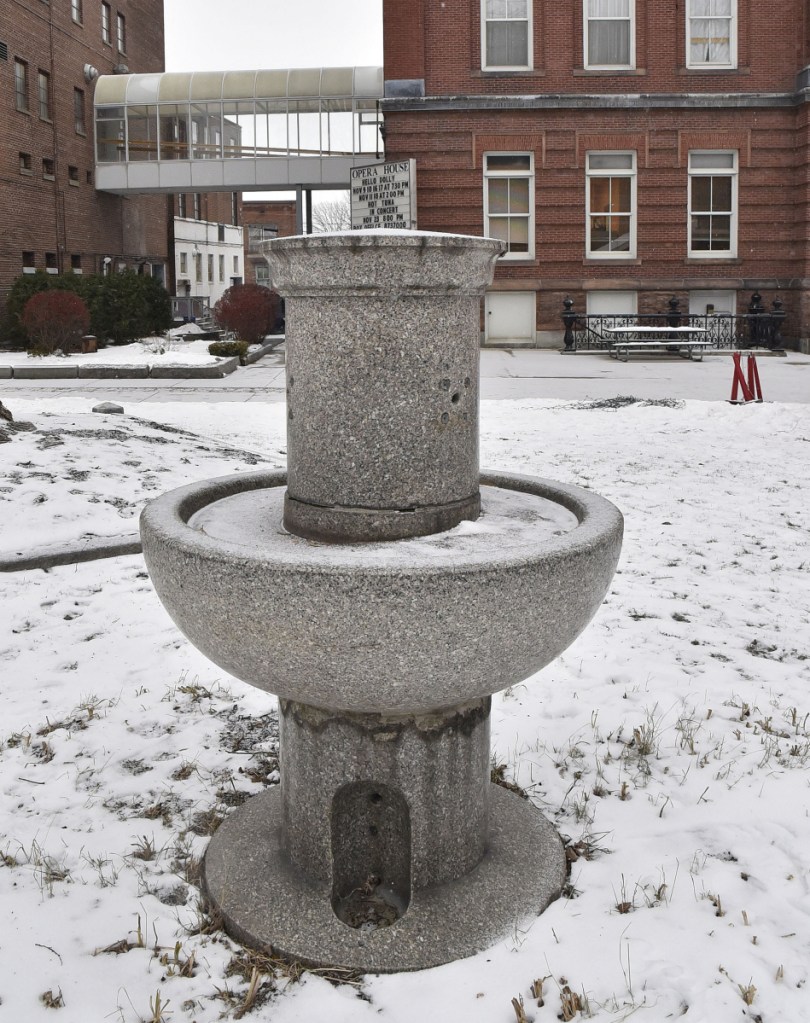There it sits in the snow, just south of the giant evergreen and historic elm tree in Castonguay Square.
The old horse watering trough is an enigma to those who don’t know its history, a treasure to those who do.
Waterville residents have been talking a lot about the city’s history lately, what with the downtown enjoying a multi-million dollar revitalization effort spear-headed by Colby College and city officials.
There’s a new $25.5 million mixed-use residential complex on Main Street with a renovated office building across the street. A boutique hotel is planned for next year farther south on the street, and sometime in the next few years, a new, gleaming art and film center will likely be built next to City Hall.
Earl Smith, former dean of the college for Colby, earlier this month launched his new book “Water Village, The Story of Waterville, Maine,” in the historic opera house to a crowd of more than 200. His is only the second comprehensive history of Waterville ever written, with the first published in 1902.
Smith, the Colby historian, talked a lot about the things we’ve demolished, like the old Memorial Hall on the former Colby campus downtown — the first college building in the nation to honor those who died in the Civil War. Smith wondered aloud what it would be like if the building, with its magnificent clock tower, had been preserved.
“Wouldn’t that be nice?” he asked.
He also cited the former city train station and St. Francis Church, both of which were razed.
“We have been far too callous about preserving reminders of our past,” Smith told the audience. “In Europe, if a building falls down and becomes a pile of rubble, they put a plaque on it, and visitors stop and gawk. In America, we don’t wait for buildings to fall down; we tear them down and then forget where they were, or even what they were. I’m afraid Waterville has to share the guilt.”
Smith’s ruminations bring me back to the old horse watering trough in Castonguay Square, which I’ve been thinking about for the last several weeks.
I recently attended two public workshops where people were exploring how best to redesign Castonguay Square. They opined about what to remove and what to keep: trees, bushes, the informational kiosk, stones bearing historical plaques, the black cannon aimed at the Morning Sentinel building — and the horse watering trough.
Some people said the granite trough should stay because it’s a part of history. Some say it should be moved elsewhere, such as to the RiverWalk at Head of Falls.
While I typically don’t weigh in on the topics of stories I cover, I am going to take the liberty of doing so regarding the poor old horse trough.
For some, it may not look very pretty, this 5-foot-plus tall granite thing that, unless someone fills you in, you haven’t a clue as to what it is.
It may not fit in with a pristine, modern version of a downtown square, but it’s a reminder of our past, and where best to put it than right where it is?
I did a little bit of research myself on the trough, which my husband, Phil Norvish, remembers writing about in the 1970s when he was a reporter for the Sentinel and the trough was being moved from the former Waterville High School — now Gilman Place on Gilman Street — back to Castonguay Square.
Yes, back.
Smith tells me that many years ago, the trough was moved from Castonguay Square to the front lawn of the school. The square, known as The Common, was created in 1796, when Waterville was part of Winslow and called Ticonic Village.
“I suspect the trough was installed sometime after 1802, when Waterville became a separate town. It did not become a city until 1887,” Smith said. “The Common was named for Arthur Castonguay in 1919, following the First World War. Castonguay Square has been renovated several times since, the last time in 1986 by an outfit called GROW (Great Revitalization of Waterville). During one of these earlier renovations, it was felt the fountain, or trough, was in the way. This is undoubtedly when my father helped move it to the high school on Gilman Street. The Gilman Street high school was built in 1912 and closed in 1964.”
For a trough that has gone through two moves already, I should think it ought to be afforded a final resting place right where it is, for whatever my vote is worth.
We could polish it up, slap a plaque on it, plant some flowers around its base and imagine horses sipping water from it in the heat of an August afternoon.
I think it would be perfectly lovely.
Amy Calder has been a Morning Sentinel reporter for 30 years. Her column appears here Mondays. She may be reached at acalder@centralmaine.com. For previous Reporting Aside columns, go to centralmaine.com.
Copy the Story LinkSend questions/comments to the editors.



Success. Please wait for the page to reload. If the page does not reload within 5 seconds, please refresh the page.
Enter your email and password to access comments.
Hi, to comment on stories you must . This profile is in addition to your subscription and website login.
Already have a commenting profile? .
Invalid username/password.
Please check your email to confirm and complete your registration.
Only subscribers are eligible to post comments. Please subscribe or login first for digital access. Here’s why.
Use the form below to reset your password. When you've submitted your account email, we will send an email with a reset code.